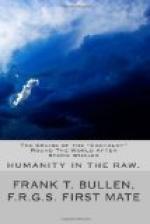*
CHAPTER XII
WHICH TREATS OF THE KRAKEN
It has often been a matter for considerable surprise to me, that while the urban population of Great Britain is periodically agitated over the great sea-serpent question, sailors, as a class, have very little to say on the subject. During a considerable sea experience in all classes of vessels, except men-of-war, and in most positions, I have heard a fairly comprehensive catalogue of subjects brought under dog-watch discussion; but the sea-serpent has never, within my recollection, been one of them.
The reasons for this abstinence may vary a great deal, but chief among them is—sailors, as a class, “don’t believe in no such a pusson.” More than that, they do believe that the mythical sea-serpent is “boomed” at certain periods, in the lack of other subjects, which may not be far from the fact. But there is also another reason, involving a disagreeable, although strictly accurate, statement. Sailors are, again taken as a class, the least observant of men. They will talk by the hour of trivialities about which they know nothing; they will spin interminable “cuffers” of debaucheries ashore all over the world; pick to pieces the reputation of all the officers with whom they have ever sailed; but of the glories, marvels, and mysteries of the mighty deep you will hear not a word. I can never forget when on my first voyage to the West Indies, at the age of twelve, I was one night smitten with awe and wonder at the sight of a vast halo round the moon, some thirty or forty degrees in diameter. Turning to the man at the wheel, I asked him earnestly “what that was.” He looked up with an uninterested eye for an instant in the direction of my finger, then listlessly informed me, “That’s what they call a sarcle.” For a long time I wondered what he could mean, but it gradually dawned upon me that it was his Norfolk pronunciation of the word “circle.” The definition was a typical one, no worse than would be given by the great majority of seamen of most of the natural phenomena they witness daily. Very few seamen could distinguish between one whale and another of a different species, or give an intelligible account of the most ordinary and often-seen denizens of the sea. Whalers are especially to be blamed for their blindness. “Eyes and no Eyes; or the Art of Seeing” has evidently been little heard of among them. To this day I can conceive of no more delightful journey for a naturalist to take than a voyage in a southern whaler, especially if he were allowed to examine at his leisure such creatures as were caught. But on board the cachalot I could get no information at all upon the habits of the strange creatures we met with, except whales, and very little about them.




